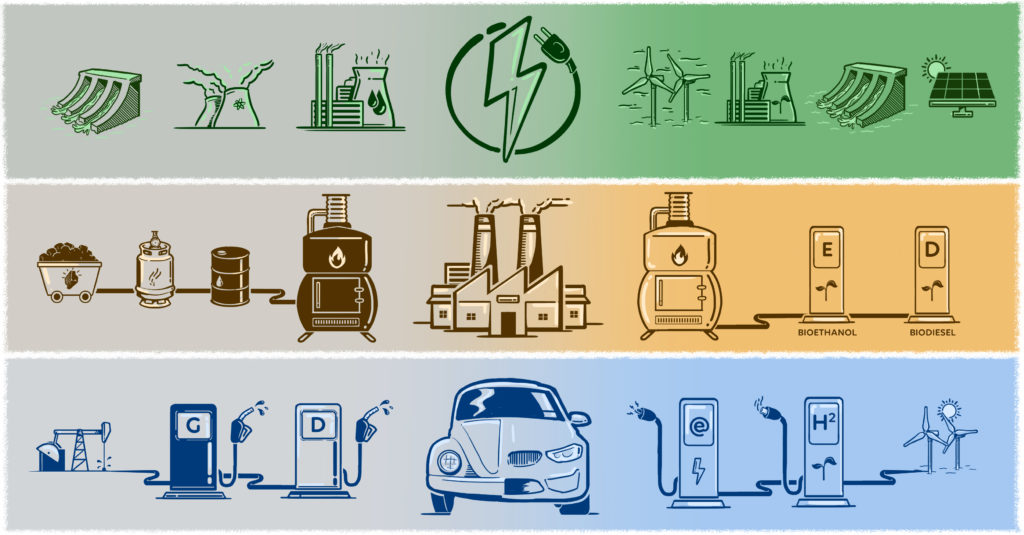
People keep asking what energy transition actually is, more precisely which sectors are going to be impacted and if they are going to be directly involved. Therefore, here is a summary of how all these questions of energy transition could be answered by starting with the definition:
Energy transition refers to the shift of the global energy sector from fossil-based (oil, natural gas and coal) to energy mix based largely on renewable energy sources (wind, solar, geothermal, hydrogen and biofuels).
All in all, the main goal is to reduce energy-related CO2 emissions, in other words, cutting down our carbon footprint to slow down climate change.
At the core of the transformation, there are several innovations divided basically in four dimensions: enabling technologies, business models, market design and systems operation. These innovations will promote a deep change in the power sector. For instance, they will highlight the importance of increasing power system flexibility to mitigate a high share of variable energy sources, such as solar PV and wind power that have been experiencing strong price reductions. Some countries, as Brazil, have more flexibility because their matrix has a large share of hydropower. Others are procuring these resources, which helps explain the renewed interest in pumped-hydro storage and batteries.
The energy transition will also create new kinds of electricity loads, to produce green hydrogen, to electrify transportation and sectors of the industry to curb emissions from fossil fuels. Finally, there is an increased role of consumers. Instead of passively paying for the electricity bills to the local utilities, they are now playing an active role in producing electricity on-site with rooftop solar, storing energy, responding to price signals (demand response) and others measures that, when combined, are accelerating the growth of decentralized power solutions that goes hand in hand with digitalization and intelligent systems.
In alignment with the global effort on transitioning to renewable energy, the Paris Agreement (COP 21) came at the right time to reinforce the global response to the threat of climate change by keeping the rise in global temperature under 2 degrees Celsius and to set up an aggressive goal to limit temperature increase to 1.5 degrees Celsius, in this century.
Thus, to achieve the 1.5 degrees Celsius cap by 2050, it is important to highlight three sectors that will most contribute to significant CO2 reduction. Power Generation: one of the basis of electricity production in large scale came from thermal power plants based on fossil fuel assuring a reliable energy supply and grid stabilization. The other two are highly energy-intensive sectors and majority of sub sectors are the hardest to decarbonise, Industry (Iron and Steel, Chemicals and Petrochemicals, Cement, Aluminium) and Transport (Road freight, Aviation, Shipping) adding here the urban vehicles as strong CO2 emission contributor.
It’s clear that the number of actions is vast, but long story short, we can point out the following actions:
1. The complete change in the sources of Power Generation transforming from coal, oil and other fossil fuels to renewable sources such as wind, solar, biomass and water.
2. Electrification of end-user sectors: replacing CO2 emission sources by equivalent electrical systems, for example, fossil fuel vehicles being replaced by electric vehicles.
3. Improve Energy Efficiency in manufacturing processes as well as Heating and Cooling in buildings. Great challenge on metallurgical activities for producing iron and steel that still requires super carbon-intensive blast furnaces.
4. Energy Storage – Deploy all type of sustainable storage solutions such as hydro pump storage and develop new technologies to reduce the cost of batteries, all focusing on the storage of wind, solar and water energy as well as promote the decentralized power generation.
5. Improve Green Hydrogen technology that can be used in many different applications in the Steel industry, Chemical industry, Refineries, Shipping, Aviation, Cars, Rail, Trucks, Buses, Heating and Power Generation.
Moreover, all these efforts to keep our planet alive and healthier depends on three main stakeholders: starting with the Society to ramp up ecological and sustainable awareness, challenge Governments to create policies that enforce rules and promote subsidies to develop and implement new technologies besides assuring attractive scenarios for Investors.
Finally, this topic is getting a high level of global coverage and is increasingly driving the agenda for new investments, where companies, banks and investors are looking for a winning combination of high attractive return of investment with a positive impact of ESG (environment, Social and Governance) practices. The financial market is already allocating a large amount of capital to promote the energy sector transition. This process will only speed up in the coming years.
References:

